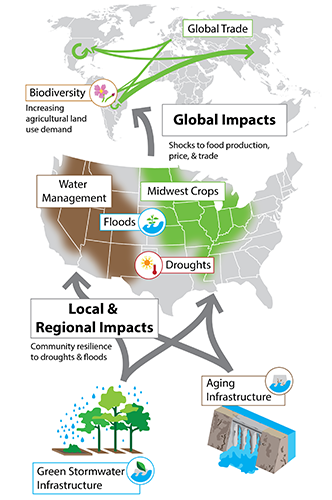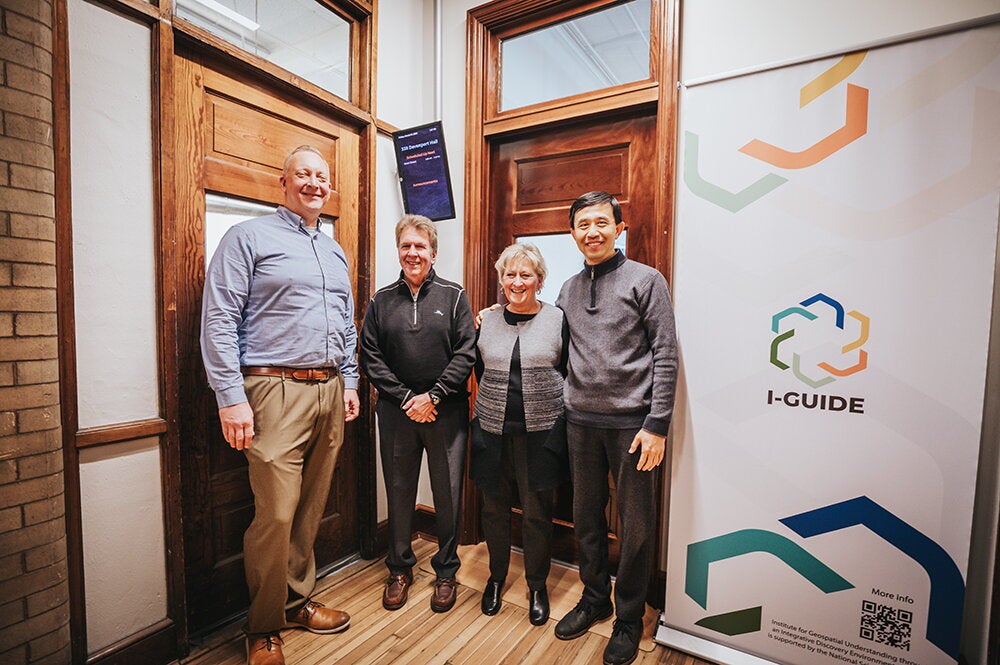

A new national initiative to enable geospatial data-driven scientific discovery will create a $15-million institute at the University of Illinois Urbana-Champaign to better understand the risks and impacts of climate change and disasters.
The Institute for Geospatial Understanding through an Integrative Discovery Environment (I-GUIDE) will receive the funding over five years as part of the National Science Foundation (NSF)’s Harnessing the Data Revolution, which establishes five institutes across the United States to explore questions at the frontiers of science and engineering.
“The goal of I-GUIDE is to revolutionize theories, concepts, methods, and tools focused on data-intensive geospatial understanding for driving innovative cyberGIS and cyberinfrastructure capabilities to address the most pressing resilience and sustainability challenges of our world such as biodiversity, food security, and water security,” said Shaowen Wang, head of the Department of Geography and Geographic Information Science at U of I and founding director of the CyberGIS Center for Advanced Digital and Spatial Studies (CyberGIS Center), who will lead the institute.
Collaborators and partner institutions from around the country that are part of I-GUIDE will work with the CyberGIS Center in partnership with U of I’s Institute for Sustainability, Energy, and Environment and U of I System’s Discovery Partners Institute.

“We’re thrilled that the National Science Foundation has established I-GUIDE in the CyberGIS Center,” said Venetria K. Patton, Harry E. Preble Dean of the College of Liberal Arts & Sciences. “This is a wonderful example of the many ways that LAS leads research and interdisciplinary collaboration that brings together talented colleagues from across campus.”
I-GUIDE aims to drive transformative advances across many fields from computer, data, and information sciences to atmospheric sciences, ecology, economics, environmental science and engineering, human-environment and geographical sciences, hydrology and water sciences, industrial engineering, sociology, and statistics.
The new institute will bring together about 40 researchers from U of I, Columbia University, Consortium of Universities for the Advancement of Hydrologic Science, Inc., Florida International University, Michigan State University, Open Geospatial Consortium, Purdue University, University Consortium for Geographic Information Science, University Corporation for Atmospheric Research, University of Minnesota, Twin Cities, Utah State University, and a variety of other partners.
I-GUIDE “creates a novel geospatial discovery environment for synthesizing data on geographically referenced social, economic, ecological, and environmental factors to better understand the risk and impacts of climate change and disasters,” the NSF reported, in a press release. Wang added, “I-GUIDE nurtures a diverse and inclusive geospatial discovery community across many disciplines by bridging disciplinary digital data divides with broader impacts amplified through a well-trained and diverse workforce and proactive engagement of minority and underrepresented groups.“

Chancellor Robert Jones said the University of Illinois is pleased that the National Science Foundation has selected campus to lead efforts to better understand and address questions of sustainability.
“Through the leadership of the CyberGIS Center, in collaboration with other fantastic researchers on campus and around the country, I-GUIDE will make great strides in helping to secure the future of our communities and resources,” Jones said.
In all, NSF is investing $75 million to establish five new Harnessing the Data Revolution Institutes as part of its “Big Ideas” initiative.
“NSF’s Big Ideas are a set of 10 bold, long-term research and process ideas that identify areas for future investment at the frontiers of science and engineering and represent unique opportunities to position our Nation at the cutting edge of global science and engineering by bringing together diverse disciplinary perspectives to support convergent research,” said Manish Parashar, office director for the Office of Advanced Cyberinfrastructure at NSF.
While I-GUIDE is the only institute led by the University of Illinois Urbana Champaign, U of I researchers will be part of other institutes led by other universities. They include the Accelerated AI Algorithms for Data-Driven Discovery Institute, which will use real-time artificial intelligence coupled hardware to advance knowledge and workflow in the primary science drivers of high energy physics, multi-messenger astrophysics and neuroscience, and the Institute for Data Driven Dynamical Design, which will create new approaches and tools to design and discover dynamical materials and structures.


